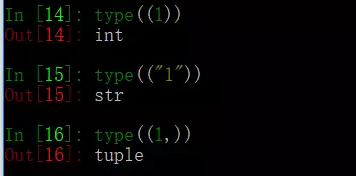面試題講解
阿新 • • 發佈:2018-12-24
1. a=(1,)b=(1),c=("1") 分別是什麼型別的資料?
2. 字串轉化大小寫
str = "www.runoob.com"
print(str.upper()) # 把所有字元中的小寫字母轉換成大寫字母 print(str.lower()) # 把所有字元中的大寫字母轉換成小寫字母 print(str.capitalize()) # 把第一個字母轉化為大寫字母,其餘小寫 print(str.title()) # 把每個單詞的第一個字母轉化為大寫,其餘小寫
執行以上程式碼輸出結果為:
WWW.RUNOOB.COm
www.runoob.com
Www.runoob.com
Www.Runoob.Com
3. 統計字串中某字元出現次數
python統計字串中指定字元出現的次數,例如想統計字串中空格的數量
s = "Count, the number of spaces."
print s.count(" ")
x = "I like to program in Python"
print x.count("i")
4.保留兩位小數
>>> a=13.949999999999999
上網查了資料,有網友提供了一種方法
>>> print "%.2f" % a 13.95
5. list=[2,3,5,4,9,6],從小到大排序,不許用sort,輸出[2,3,4,5,6,9]
ll=[]
if len(list)>0:
m=min(list)
list.remove(m)
ll.append(m)
return ll
1:Python 有哪些特點和優點?
作為一門程式設計入門語言,Python 主要有以下特點和優點:
可解釋
具有動態特性
面向物件
簡明簡單
開源
具有強大的社群支援
3. 列表和元組之間的區別是?
答:二者的主要區別是列表是可變的,而元組是不可變的。舉個例子,如下所示:
x in s |
True if an item of s is equal to x, else False |
(1) |
x not in s |
False if an item of s is equal to x, else True |
(1) |
s + t |
the concatenation of s and t | (6)(7) |
s * n or n * s |
equivalent to adding s to itself n times | (2)(7) |
s[i] |
ith item of s, origin 0 | (3) |
s[i:j] |
slice of s from i to j | (3)(4) |
s[i:j:k] |
slice of s from i to j with step k | (3)(5) |
len(s) |
length of s | |
min(s) |
smallest item of s | |
max(s) |
largest item of s | |
s.index(x[, i[, j]]) |
index of the first occurrence of x in s (at or after index i and before index j) | (8) |
s.count(x) |
total number of occurrences of x in s |
s[i] = x |
item i of s is replaced by x | |
s[i:j] = t |
slice of s from i to j is replaced by the contents of the iterable t | |
del s[i:j] |
same as s[i:j] = [] |
|
s[i:j:k] = t |
the elements of s[i:j:k] are replaced by those of t |
(1) |
del s[i:j:k] |
removes the elements of s[i:j:k] from the list |
|
s.append(x) |
appends x to the end of the sequence (same as s[len(s):len(s)] = [x]) |
|
s.clear() |
removes all items from s (same as dels[:]) |
(5) |
s.copy() |
creates a shallow copy of s (same as s[:]) |
(5) |
s.extend(t) or s += t |
extends s with the contents of t (for the most part the same as s[len(s):len(s)]= t) |
|
s *= n |
updates s with its contents repeated ntimes | (6) |
s.insert(i, x) |
inserts x into s at the index given by i(same as s[i:i] = [x]) |
|
s.pop([i]) |
retrieves the item at i and also removes it from s | (2) |
s.remove(x) |
remove the first item from s where s[i] ==x |
(3) |
s.reverse() |
reverses the items of s in place | (4) |
13. 請解釋使用 *args 和 **kwargs 的含義
當我們不知道向函式傳遞多少引數時,比如我們向傳遞一個列表或元組,我們就使用 * args。
- 1>>> def func(*args):
- 2 for i in args:
- 3 print(i)
- 4>>> func(3,2,1,4,7)
執行結果為:
在我們不知道該傳遞多少關鍵字引數時,使用 **kwargs 來收集關鍵字引數。
- >>> def func(**kwargs):
- 2 for i in kwargs:
- 3 print(i,kwargs[i])
- 4>>> func(a=1,b=2,c=7)
位置引數(不要是可變型別),可變引數(*args),預設引數,命名關鍵字引數(必須按名傳參,引數位置可以改變*,名字1,名字2),關鍵字引數(在最後,以字典的形式列印)
命名關鍵字引數前如果有可變引數的話,他的*是可以省略額的==

